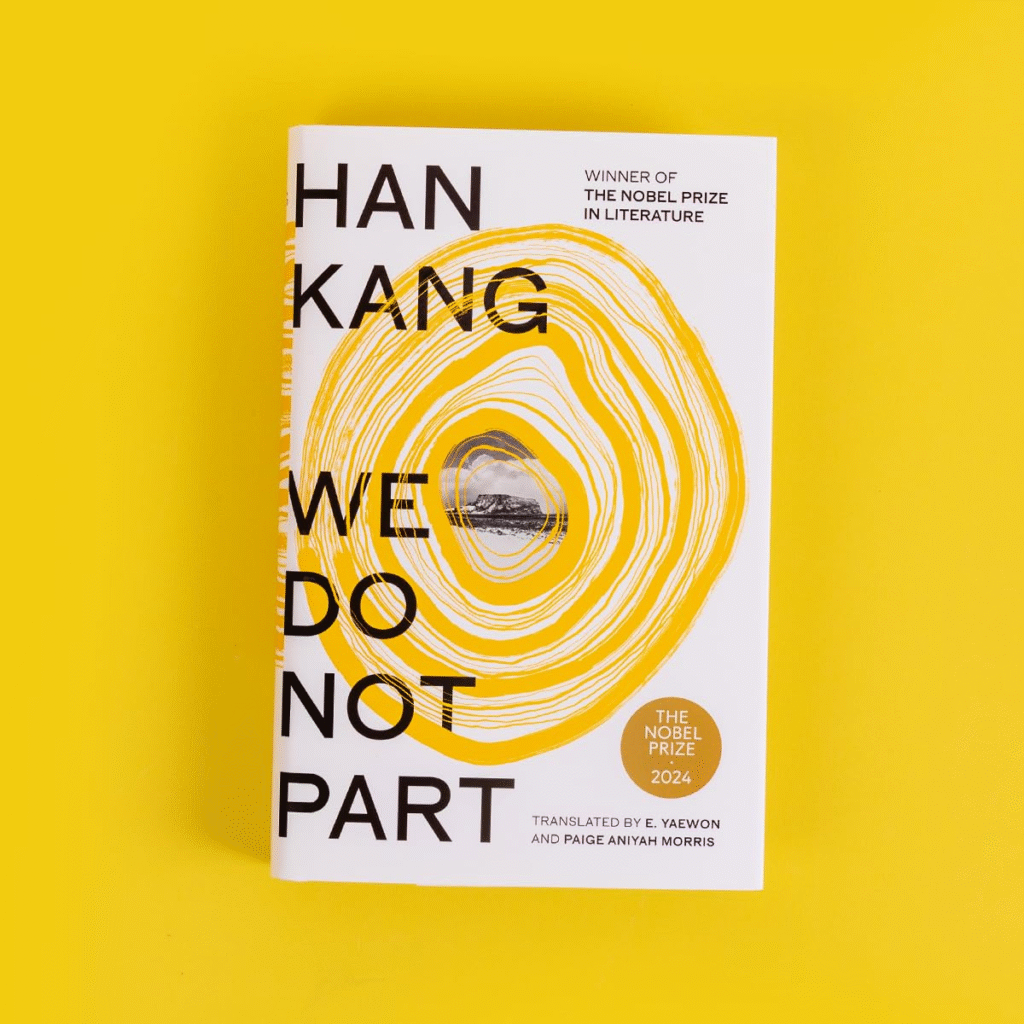We Do Not Part is the powerful new novel by Han Kang, winner of the 2024 Nobel Prize in Literature, now released in English translation in 2025. Largely set on Jeju Island, this haunting story begins with a simple request from an injured friend, but soon unfolds into a journey through memory, grief, and historical silence. What begins as Kyungha’s desperate attempt to save a fragile white bird leads her into the darkness of South Korea’s past specifically the 1948–1949 Jeju massacre, when over 30,000 civilians were slaughtered and 40,000 forced to flee to Japan in an anti-communist crackdown. As the snow falls endlessly, reality and dreams collapse into each other, revealing how personal lives remain mixed with buried atrocities.

We Do Not Part is both an intimate portrait of friendship and a piercing reflection on forgetting. The narrative weaves together nightmares, memories, and historical records to reveal how trauma flows from mother to daughter, passing through generations as survivors struggle to carry the unbearable. “History is like a horror story…” writes Roberto Bolaño, a line Han Kang seems to echo as she shows how the past never truly disappears but lingers in silence, shadows, and snow. More than poetic storytelling, this novel becomes a courageous act of historical remembrance, unearthing voices that refuse to be silenced.
In this Han Kang novel,We Do Not Part shows how dreamlike narration becomes a way to confront buried truths. Kyungha’s journey is not just physical but psychological, blurring the boundary between waking and dreaming as she steps into a past heavy with silence. The haunting line, “The thing is, every time it snows, it comes back. I try not to think about it, but it keeps coming back,” reflects how memory works, returning uninvited, like snowflakes that seem light yet accumulate into an unbearable weight. Here, snow becomes a metaphor for grief and historical trauma that can never truly be erased, no matter how much one tries to forget.
More than a Jeju Island massacre history book, We Do Not Part is a lyrical meditation on loss, love, and resilience. Han Kang captures the fragility of human life as snowflakes, birds’ wings, flickering candles as symbols against the vast weight of violence and erasure. By weaving together dreamscapes and brutal realities, the novel asks how we remember, how we witness, and how we live on. For readers looking for the best translated books 2025 or a profound Nobel Prize in Literature 2024 novel review, this masterpiece will stay with you forever.
Read Also: Hunchback | Saou Ichikawa | Book Review
Availability & Details of Book

We Do Not Part by Han Kang, translated by e. yaewon and Paige Aniyah Morris, is available in multiple formats for readers in India. The hardcover edition (384 pages, published by Hamish Hamilton / Penguin Random House Ireland Limited, 6 February 2025) is priced around ₹628, while a more affordable paperback version can be found on Flipkart for about ₹264, discounted from its original price. The Kindle eBook is available at approximately ₹596, making it a convenient choice for digital readers. For those who prefer listening, the audiobook version, narrated by Greta Jung, is accessible through Audible India, free with a 30-day trial and later available at ₹199 per month under subscription. Readers can purchase the book through major online platforms such as Amazon India, Flipkart, and BookisHamper, as well as from select local bookstores like Crossword or Landmark. With multiple editions and formats print, digital, and audio, We Do Not Part ensures accessibility for every type of reader.
Read Also: Eurotrash | Christian Kracht | Book Review
Characters We Do Not Part
Kyungha: Kyungha, the narrator, is a writer whose life is shaped by both her own nightmares and the silences of history. Through her eyes, the novel becomes a bridge between the present and the past, as she is drawn into the forgotten massacre on Jeju Island. She embodies the role of witness and someone who did not directly experience the violence but who carries its aftershocks through memory, empathy, and storytelling. Her recurring visions of snow reveal how trauma resurfaces in unexpected ways, refusing to stay buried. Kyungha’s journey reminds us that to listen, record, and remember is also a form of resistance.

Inseon: Inseon, Kyungha’s close friend and a filmmaker, anchors the story in lived memory. Her family’s history is inseparable from the Jeju massacre, making her both survivor and inheritor of generational trauma. Through her, Han Kang explores how the past lives on in children and grandchildren, shaping identities long after the violence has ended. Inseon’s role is not only to remember but also to insist that the truth be shared, even when silence feels safer. Her relationship with Kyungha shows how friendship can carry the unbearable weight of memory, transforming private grief into collective testimony.
Jeongsim: Jeongsim, Inseon’s mother, represents the older generation of survivors who lived through the bloodshed firsthand. Her memories are marked by terror, loss, and the constant pressure to remain silent in a country where speaking the truth could mean more danger. She becomes a figure of both strength and fragility, holding stories that are too painful to tell yet too important to forget. Through Jeongsim, Han Kang shows how trauma reshapes the body and voice, leaving behind silences that future generations must learn to interpret. Her presence makes the novel an act of intergenerational conversation, where the dead speak through the living.
The Survivors: Beyond the central characters, the novel gives space to the unnamed survivors of Jeju. These voices, whether found in archives, memories, or fragments of testimony, remind us that history is not abstract but made up of countless individual lives. Han Kang refuses to reduce them to statistics, even as we are told that 30,000 were killed and 40,000 fled to Japan. Instead, she restores humanity to their suffering, giving dignity to stories long erased by official silence. The survivors are both real and imagined and become the novel’s deepest conscience, calling on readers to bear witness alongside Kyungha and Inseon.
Read Also: The Emperor of Gladness | Ocean Vuong | Book Review
Thematic Analysis of We Do Not Part by Han Kang

At the heart of We Do Not Part are Kyungha, a writer haunted by nightmares of past massacres, and Inseon, her filmmaker friend whose family history is bound to Jeju Island’s silenced atrocities. Through their bond, the novel delves into themes of memory, intergenerational trauma, fragile bonds of friendship, and the struggle to bear witness to violence, showing how personal lives remain inseparable from collective history.
- Memory and Historical Trauma: At the center of We Do Not Part is the question of how memory survives when history itself is suppressed. The novel looks back at the Jeju Island massacre of 1949, when nearly 30,000 civilians were killed and 40,000 fled to Japan during the government’s anti-communist crackdown. Survivors carry this pain not only in official archives but also in their bodies, their silences, and their dreams. By layering personal memory with historical testimony, Han Kang reminds us that the past does not simply vanish and it lingers, shaping how generations after continue to live, love, and fear.
- Friendship and Hope as Forms of Survival: Kyungha’s journey begins with a request from her filmmaker friend Inseon, whose family history is deeply tied to Jeju. Their friendship is not only personal but also symbolic: it shows how bonds of care can become forms of protection and responsibility. In a world where violence isolates and silences, friendship insists on closeness and it becomes the force that helps the characters confront trauma and carry unbearable memories together. Han Kang shows how, when official history abandons survivors, human connection offers its own fragile archive of support, tenderness, and endurance.
- Dreams and Reality Interwoven: In We Do Not Part, Han Kang blurs the line between sleep and waking so that the past keeps pushing into the present. As the narrator says, “Dreams are terrifying things. No — they’re humiliating. They reveal things about you that you weren’t even aware of…”, and throughout the book dreams act less like escape and more like a force that forces hidden truths out into the open. Strange, oneiric images like black trees, seawater, sudden lulls which pull memory into the now, making old violence feel immediate and unavoidable. By folding dream into reality, the novel shows how trauma changes the way people see the world and themselves, so that what was once buried keeps returning to be faced.
- Intergenerational Trauma: Trauma in We Do Not Part is not confined to a single moment in time. It travels across generations moving from mothers to daughters, fathers to children, and even from the dead to the living. Through Jeongsim’s archives and testimonies, we see how the silence of one generation becomes the haunting of the next. The novel reveals that history is not a closed chapter but a living wound that continues to pulse in new bodies and new times. This transmission becomes both burden and responsibility, asking younger generations to carry truths that others were forced to suppress.
- The Body as Archive: In We Do Not Part, pain and survival are written on the body itself. Injuries such as severed fingertips, repeated needle-pricks, and the weariness of age show how physical marks become evidence of hidden histories. The body becomes an archive and storing what words cannot speak and what documents fail to record. In this way, survival is itself testimony: each scar, ache, and gesture becomes a record of violence endured and resilience sustained. Han Kang uses these embodied details to remind us that the past lives not only in memory but in flesh and bone.
- Snow as Symbol of Trauma: Snow recurs throughout the novel as one of its most haunting and enduring metaphors. At once beautiful and suffocating, snow represents silence, erasure, and the persistence of buried grief. Like trauma, it returns again and again, layering itself over the present until it becomes impossible to ignore. Snow is not merely weather instead it is a living force in the narrative, a reminder of what has been suppressed and what refuses to vanish. Its cold presence captures how memory settles in cycles, covering but never erasing the traces of violence.
- Women as Keepers of Memory: Han Kang places women at the heart of remembrance. Jeongsim, Inseon’s mother, carefully collects letters, newspaper clippings, and testimonies, creating an unofficial archive of Jeju’s silenced history. Her labour highlights how women often bear the responsibility of carrying memory forward when official channels attempt to erase it. These quiet acts of gathering, preserving, passing on become radical forms of survival. By giving this role to women, the novel honors their work as protectors of truth, turning small, private acts into powerful resistance against erasure.
- Silence and Censorship: For decades, the Jeju massacre was unspeakable in South Korea, and silence became a survival strategy for many. Han Kang captures this chilling truth by showing how silence weighs on characters as heavily as words. Yet silence in the novel is double-edged: while it protects, it also threatens to erase. The act of breaking silence even falteringly is therefore crucial, because it resists the state’s attempts to bury history. We Do Not Part insists that to remain silent is to risk betrayal, while to speak is to resist erasure, even when language feels fragile.
- The Ethics of Witnessing: The novel is deeply concerned with the ethics of art and memory: how can we bear witness to violence without turning it into spectacle? Through Kyungha, a writer, the novel stages this dilemma. She feels both the urgent need to testify and the fear of exploiting suffering. We Do Not Part refuses easy answers, instead forcing readers to sit with the difficulty of truth-telling. Witnessing, in this novel, is not a completed act but a constant negotiation between responsibility and restraint.
- Objects, Nature, and Everyday Symbols: Candles, birds, trees, and snow carry deep symbolic weight in the novel. These everyday objects become vessels of memory, simple, ordinary things transformed into echoes of grief and persistence. By grounding trauma in these material details, Han Kang makes history feel present and tangible, reminding us that violence leaves traces even in the smallest things. A single bird taking flight or a candle flickering in the dark becomes more than an image and it is a reminder of lives lost and the endurance of those left behind. These quiet symbols make the novel feel both intimate and universal, connecting private memory to the natural world around us.
- Hope in Small Gestures: Despite its weight, We Do Not Part does not end in despair. Instead, Han Kang finds hope in the smallest of gestures in a friend’s presence, a mother’s letter, the flutter of a bird’s wings. These moments do not erase grief, but they make survival possible. Hope here is quiet, fragile, and incomplete, yet it matters because it resists the total darkness of forgetting. Even the act of listening to another’s story becomes an offering of care, showing that solidarity itself is a form of light. In this way, the novel teaches us that survival is not heroic, but shared through tenderness and persistence.
- The Meaning of the Title: Finally, the title We Do Not Part becomes a promise and a practice. It is a vow not to part from the dead, not to part from truth, and not to part from each other in the work of remembering. In a novel about separation, exile, and suppression, this refusal to part becomes an act of defiance in a way of saying that memory, friendship, and love endure even when history tries to erase them. The title also speaks to the reader, drawing us into the work of remembrance and refusing to let us walk away untouched. It lingers as both comfort and demand, reminding us that choosing not to part is itself a radical act of connection.
- Witnessing, Art, and the Ethics of Representation: The novel is deeply concerned with the responsibility of telling trauma. On one level, Kyungha embodies the personal burden of witnessing and struggling to write about violence without exploiting it, to speak when silence feels safer yet more dangerous. On another, the book asks what role art, film, and literature play in collective remembrance: how do cultural works preserve history without turning suffering into spectacle? By intertwining personal and public responsibility, Han Kang insists that ethical creation requires humility, honesty, and a refusal to let horror be forgotten.
- Silence, Guilt, and the Weight of Responsibility: For decades, the Jeju massacre was silenced by censorship, forcing survivors into secrecy as a survival strategy. Yet silence, while protective, also becomes heavy with guilt and a complicity that risks erasing memory altogether. The novel presses on this tension: how silence shields but also betrays, how it saves individuals yet harms collective truth. By confronting the moral weight of complicity, Han Kang shows that remembrance requires courage not only to resist censorship, but to face the responsibilities of history and the costs of choosing silence.
- State Violence and Political Context: The political machinery behind the Jeju tragedy underlies everything in We Do Not Part. The novel places personal grief against the backdrop of state policies, military action, and Cold War politics that enabled mass killing. By linking private stories to public structures, Han Kang makes clear that remembrance is not only emotional work but political work too: naming history challenges official silence and helps demand accountability.
Notable Quotes from We Do Not Part
Read Also: Dream Count | Chimamanda Ngozi Adichie | Book Review

- “Come to the hospital. I need you.”
This simple plea encapsulates what drives the story. Inseon’s request isn’t just practical but it’s a call to presence, intimacy, and loyalty. That text pulls Kyungha out of isolation and into a journey of memory and care, demonstrating that compassion can bring history back to life.
- “Snowflakes resembling a flock of tens of thousands of birds appear like a mirage and sweep over the sea.”
This image turns snow into an almost hallucination, vast, animate, and haunting. It symbolizes how the weight of past atrocities flows back into the present, like a swarm impossible to ignore.
- “Am I dead?”
These stark words echo a moment when Kyungha wonders if the snow-covered isolation has erased her sense of life. It captures the novel’s dreamlike disorientation and reminds us how trauma can fracture our sense of reality.
- “Looking squarely at the injury made it all the more excruciating.”
Borrowing from Nietzsche’s warning about gazing into an abyss, this reflection shows that facing atrocity head-on intensifies pain but it’s also how truth persists. This unflinching honesty is at the heart of Han Kang’s commitment to remembrance.
- “My every pain and joy, all my deep-rooted sorrows and loves, shine… glowing together as one giant nebula.”
This beautiful metaphor captures Kyungha’s emotional complexity and the idea that memory, grief, and love aren’t separate, but colliding constellations above her conscience. It highlights the novel’s emotional depth and resonance.
- “I retraced the sequence of events… [and] I could feel myself changing. To the point where it seemed nothing one human being did to another could ever shock me again.”
This moment spoken by Inseon as she sifts through records of mass killings and shows how confronting relentless violence can numb even survivors. Han Kang reminds us that bearing witness can break a person in unexpected ways, forging a connection not just to trauma, but to the scars of humanity itself.
- “Looking squarely at the injury made it all the more excruciating.”
Adapted from the novel’s own reflection, this phrase highlights Han Kang’s belief: understanding history’s brutal truths is painful, but necessary. We Do Not Part doesn’t shy away from the damage because it stares directly into the wound, honouring pain as the price of full awareness and empathy.
- From The Conversation: “Inseon’s nightmares… carry the wounds of those histories.”
This commentary underscores that the trauma depicted isn’t abstract and it’s embodied and inherited. Through Inseon, Han Kang shows that personal nightmares are not her own but echo the island’s buried tragedies. Memory, in other words, isn’t just mental and it is multi-generational and painfully alive.
- “the lone path that bore my deep footprints lay in silence,”
When Kyungha reaches the house, she finds Ama dead, yet the bird’s sudden revival unsettles her grip on reality. Inseon, though hospitalized, also appears to share her family’s survival story, showing how memory collapses time and place. As the novel reminds us, blurring the boundaries between the real and the remembered.
Read Also: The Book of Disappearance | Ibtisam Azem | Book Review
Why Read We Do Not Part
Han Kang’s We Do Not Part is not just a novel and it is an act of remembrance. It carries us into the silenced history of the Jeju Island massacre and shows how memory endures in bodies, objects, dreams, and human connections. The novel does not let the past remain hidden; it insists that grief, silence, and scars are part of living history that continues to shape the present.

What makes this book powerful is its tenderness. Amid the weight of trauma, it finds moments of care, friendship, letters, snow, birds, gestures of love that make survival possible. Han Kang asks difficult questions: How do we witness suffering without exploiting it? How do we honour stories that were censored for decades? And how do we keep from parting each other, from truth, from the dead?
Han Kang’s writing style is both lyrical and restrained, carrying the rhythm of poetry while holding the weight of history. Her sentences shift between stark simplicity and haunting imagery, making silence as meaningful as words. One passage reflects on the fragility of existence itself: “Life was exceedingly vulnerable. I realized. […] the breaths passing before my eyes held within them the potential to snap … so easily, and by a single decision.” This stark awareness contrasts with moments of hushed beauty, as in her description of snowfall: “Snow had a surreality to it … There was an accompanying clarity to snow as well, especially slow, drifting snow.” Even the smallest flicker of snow or the trembling of a hand becomes charged with memory. The language does not sensationalize trauma; instead, it unfolds gently, asking the reader to listen with patience and care. This balance of beauty and gravity is what makes Han Kang’s prose unforgettable.
To read this novel is to step into an ethical conversation about memory and responsibility. It is haunting yet deeply humane, showing us that even in the face of erasure, memory insists on returning. If you value literature that stays with you, that challenges silence while holding space for tenderness, We Do Not Part is not a book you simply read and it’s a book you carry.
Final Thoughts
Han Kang’s We Do Not Part is more than a novel and it is an act of ethical remembrance. Through its exploration of trauma, silence, friendship, and fragile hope, it shows us that the past is never fully gone. Memory returns in the body, in objects, in snow, and in dreams, refusing erasure no matter how heavily silence weighs. The novel compels readers to face history not as something distant, but as a living force that shapes the present.
What makes the book unforgettable is its insistence on tenderness alongside grief. Amidst silence and scars, there are gestures of love, friendship, and resilience that keep memory alive. As Han Kang reminds us, “We cannot part from the dead, from memory, from each other.” To read this novel is to accept that remembrance is a form of resistance and that carrying these stories is part of our shared responsibility.




